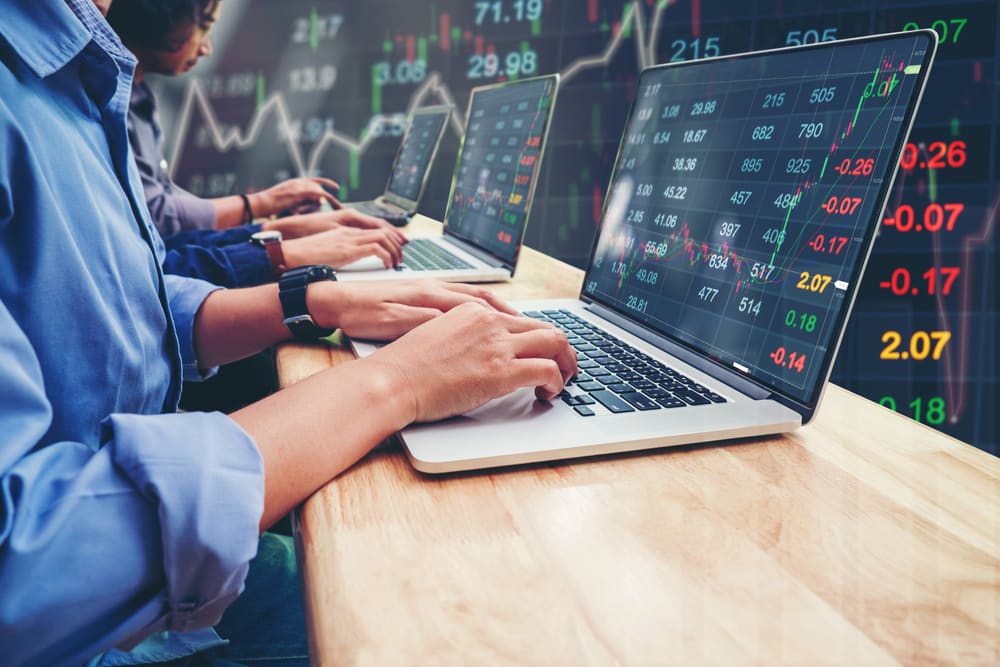
Trading Tutorial – Active Trading vs. Day Trading
Trading in financial markets involves so many trading methods. If you have just entered the trading world, you might ask what active and day trading are and if there are any differences. In this piece of writing, we focus on active trading vs. day trading aspects, explaining the nuances between these two trading strategies.
Active trading vs. day trading – Active Trading definition
Active trading is buying and selling stocks or other securities for a quick profit. It’s based on short-term price movements. The aim is to hold the trading position for a short period. There’s no precise time measurement when it comes to active trading. Day traders making tens or hundreds of trades per day are very actively trading. Also, swing traders who open or close positions every couple of days are active traders.
Active traders focus on high liquidity markets such as stocks, Forex, futures, and options. They typically use high volumes of trades to make a profit because the price swings tend to be relatively small over a short period. Active traders also use a variety of trading order types. One of the most common trading orders is a stop order. For instance, if there’s resistance at 50 USD, they may set a buy stop at 50.05USD. It sends an order to buy id the price reaches 50.05 USD
A stop-loss order helps keep losses manageable if the price goes against the trader.
To capture a favorable price, the trader may use a limit order. If a stock is trading at $50, but a trader wants to see if they can buy at $49.50 on a quick drop, they could place a limit buy order at $49.50. Also, they could place a limit sell order to leave the position at $51.
These orders enable the trader to buy and sell without focusing on the price every second during the day. Active traders set their orders and know that they will trigger if the price reaches a certain level.
Active traders trade within a short time. Fundamental and economic aspects don’t play a big role in their trades. Technical and statistical analysis play a bigger role. Many active traders’ trading is based on price action or technical indicators.
Active Trading Strategies
We can group active traders within three categories. Each category tends to trade on different time frames and amounts, even though they represent all short-term traders.
Day trading
Day trading comprises buying and selling a security during a single day. The trade is usually made in an attempt to benefit from a specific event expected to affect the stock’s price. These traders typically use one to fifteen-minute charts.
Scalping
If the right decisions are made for immediate profitability, scalping is the best option. It is about carrying out ultra-fast financial transactions in a few seconds, which requires unfailing concentration and instantaneous decision-making.
Swing trading
Swing trading requires a reaction time of a few hours for purchases that will be kept for a few days or several weeks before being resold. The following options are quite similar, except that the acquired financial assets are not retained. They are often resold during the same session, sometimes with a reaction time that does not exceed 30 minutes.
Position Trading
Many consider position trading as a buy-and-hold strategy. However, it can be a form of active trading. Position traders use longer-term charts, from daily to monthly, in combination with other methods to determine the current market direction. Position trading may last for several days to several weeks and longer.
Trend traders seek to determine the market direction, but they do not aim to forecast price levels. They jump on the trends after they have established themselves. Once the trend breaks, they exit the position. In periods of high volatility, position trading is more tricky, and positions are generally reduced.
Active trading vs. day trading – What is day trading?
Highly developed in the United States, Day Trading has more and more followers of this very aggressive investment technique. The purpose of the Day Trader is to go back and forth during the day. Purchases and sales are always closed before the market closes to have a completely liquid portfolio during trading hours.
The technique will make small capital gains by using a strong leverage effect and multiplying the transactions to maximize the return. Thus the day trader will take advantage of market volatility and settle for gains of between 0.5 and a few percent per transaction. Some investors thus place dozens of orders per day.
Each position is closed at the close of the market. The day trader will not hesitate to take losses when necessary. For that, he will not wait to have lost 10% of his position. The game aims to make more winning trades than losers and ensure that losses are as small as possible when they are losing.
Here we will overview the basics of day trading rules and the questions you should ask yourself before tackling this very “sporty” technique.
How much capital to start with?
The minimum sum to practice day trading is not so significant. Unlike traditional stocks investment, you will use the leverage effect (on shares or futures), which increases your financial possibilities and focuses only on a few lines. It is not uncommon for the day trader to be positioned in only one stock at a time with high leverage.
Consequently, even a modest budget may suffice. It will be enough that the brokerage fees do not amputate your small percentages of gain too much.
Markets for day trading
Two conditions must be met to be able to indulge in day trading: liquidity must be significant as well as volatility. Liquidity represents the number of exchanges that take place each day on security. Several million shares are traded every day on shares, which ensures that you can get in or out of the shares at any time. There is always a counterparty ready to buy back your shares or sell them to you.
If you do day trading on equities, the kingdom of liquidity remains above all the United States with the Dow Jones or the Nasdaq flagship securities. Similarly, futures represent a very good alternative. These derivative products also offer considerable leverage. These markets thus offer many opportunities for online trading.
Finally, significant volatility on the securities worked is the second condition i
Day trading: a profitable practice?
By its approach, day trading is highly speculative, so gains are uncertain. Some traders manage to do well, but it is a risky strategy that requires certain know-how, a good understanding of the financial markets, and appropriate risk management.
Day trading takes advantage of price volatility leading to bullish or bearish movements in the short term; however, long-term investing is a practice of investing in creating business value.
Therefore, the success rate is higher with investment than with day trading compared to the risks involved. Additionally, some financial experts explain that passive trading strategies perform better over long periods than active ones, especially when accounting costs are considered.
Day trading strategies
Day trading enthusiasts generally implement several strategies. Here are the main ones.
News trading
News trading occurs when a trader enters and exits the market before or after releasing an important economic statistic for the markets by exploiting volatility to the maximum. Among the ‘market movers’ having the most impact on the markets, we find the figures for inflation, employment, and growth because they will influence central banks’ decisions concerning their monetary policies.
Range trading
Range trading allows day traders to take advantage of price movements between highs (supports) and lows (resistances) during a sideways trend where neither buyers nor sellers have control of the market.
Breakout Trading
Trading breakouts allow you to take advantage of price acceleration when an asset crosses or breaks a key price level. To optimize your results, you need to ensure that certain market patterns exist, such as consolidation before a breakout and an increase in trading volume at price acceleration, indicating investors’ willingness to support prices as far as possible.
Technical analysis
Technical analysis is at the heart of the majority of day trading strategies. It is based on analyzing price action and using technical indicators to try to spot key price areas, moments of acceleration prices, reversal or pull-back conditions or confirmation, and reversal or indecision chart patterns.
Which products to use for day trading?
In order to achieve results using day trading, it is important to use derivatives such as CFDs (contracts for difference), options (call options and put options), or futures (futures contracts) which are based on the leverage to magnify price fluctuations.
However, such a trading technique is risky if the market moves against you. Therefore, it is important to have good risk and money management, especially with stop-loss orders, to better preserve your trading capital.





